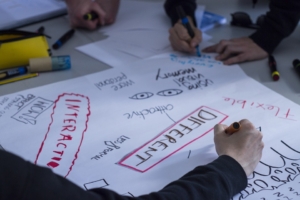Should Skills Testing be a Standard Operating Procedure for Hiring?
By Dana Borowka, MA
I’ve noticed an interesting trend that I want to share with you. In the past 12 months we’ve been receiving a lot more questions about pre-employment skills testing. We’ve taken notice. Something has shifted. Companies that had never before considered using skills testing in their hiring process, now ‘suddenly’ had an interest in learning more. Other companies that had used skills testing only sparingly were exploring what additional tests were available.
Yes, something was up alright. As I talked with these companies the reason behind their intensified interest in skills testing became clear.

Elephant in the room by David Blackwell
The Elephant in the Room
Every company I spoke to was having an exceedingly difficult time hiring people that had the right skills for the job, no matter what the job. The elephant in the room during these discussions was that companies were getting burned time and time again. The cost of the hiring mistakes was escalating. Too many candidates who went through the screening and hiring process failed to perform up to expectations once on the job.
Anecdotally, I knew this was a big problem. Employers can’t be 100% certain that a candidate has the right skills based on resume, references, and interviews. Even in-depth work style and personality assessments, like we do for our clients, aren’t designed to verify job skills. I wondered just how big a problem it is. I did some research.
The Department of Labor estimates the cost of a bad hire is equal to at least 30% of first year salary. “Wow”, I said to myself, doing some quick math in my head. Hire a $30,000 bookkeeper that doesn’t have the right bookkeeping skills, and there’s a $9,000 hit to the bottom line. Hire a $50,000 PC administrator without the right technical skills, write off another $15,000.
These numbers got me to think about what contributes to the high costs.
1. Lost time and productivity of the people involved in the hiring process
2. The new employee’s mistakes often have hard costs associated with them – poor service or product quality for example
3. The productivity of the new hire is well-below expectations
4. The possible negative impact on customers and your brand image
5. Training the new hire to achieve a skill-level they should have had in the first place
6. Replacing the employee
As managers we know the hassle and frustration attached to hiring someone without the right skills. What’s more, there are considerable hard and soft costs associated, too, as the list above shows and the Department of Labor statistics prove.
Is Skills Testing the Panacea for Hiring Mistakes?
With a problem this large we at LCS saw an opportunity. We’re now offering a catalog of online skills tests for our clients. But, I’m getting ahead of myself. Let me explore with you how skills testing is best used. I’ll debunk a few myths along the way.
How Skills Testing is Best Used
If you really want to improve the success of your new-hires, incorporate skills testing and personality assessments in the hiring process. Nothing is fool-proof, but believe me, if you do both types of testing together with smart interviewing, your new-hire success rate will go way up. The failure rate (and the costs associated with it) will drop like a rock.
I’ve been a proponent of skills testing for a very long time, IF they are used properly. Skills testing is a tool, like so many others available to managers. Tools can be misused. Tools can be trusted too much.
Here’s the point. Just because a candidate has the right skills for a specific role in your company doesn’t mean you should hire the person. A great skills test score doesn’t mean the person will be a great fit in your company.
The mistake that I’ve seen made by hiring managers is to place too much weight on skills test results. Good resume, good references, interviews went well, aced the skills test – fabulous, make that woman an offer fast!
Not so fast. Is her work style a good match for the role? Is her personality a good fit for the level of responsibility and interaction necessary? Skills testing doesn’t venture into these waters. This is the realm of the in-depth work style and personality assessment.
Skills Testing Only Works if you Know What Skill Level Matters
I can’t emphasize this point enough. If your company hasn’t identified the specific skills required for each position, a test is not going to be all that useful. Let me use a sports analogy.
 A track coach has try outs for his sprint team. Five athletes show up wanting to make the team for the 100-meter event. The coach gets out his stop watch. Lines all five at the starting line and fires the starting gun. Bang. Off they run.
A track coach has try outs for his sprint team. Five athletes show up wanting to make the team for the 100-meter event. The coach gets out his stop watch. Lines all five at the starting line and fires the starting gun. Bang. Off they run.
The coach looks at his watch as the first racer crosses the finish line several steps ahead of the others. Click. The fastest racer covered the 100 meters in 11.2 seconds. Better than the other four. Does the coach offer the racer a position on the team? He will if he doesn’t know what speed is necessary for his 100-meter squad to compete effectively. Sure, he’ll have a racer for the 100 meter event, but the team will never win. He won’t offer the position to any of the five candidates if he knows that a pace of at least 10.1 seconds is necessary to win in his conference. In this case the required skill is running the 100 meters in 10.1 seconds or less.
The Never-Ending Search for the Perfect Candidate
LCS is deeply involved in the active hiring processes of hundreds of clients. I make this claim just to point out that few companies are better positioned to observe and assess the hiring practices of so many companies. What we’ve noticed is companies tend to fall into two categories. Those that take too long to find and hire employees. And those who have found a way to hire more quickly and retain those employees. What is the difference?
There are many facets to this. Most are beyond the scope of this article, but one is very relevant. The companies who are the most successful realize that the perfect candidate doesn’t exist. They know it’s fool-hardy to spend valuable time and resources searching for the perfect person.
They identify the best person available and which areas will need to be developed in that person once hired. This change in strategy presents an integrated view of hiring and training. So, where does skills testing enter the picture?
Let’s go back to the race track. The coach has one athlete who ran the 100 meters in 11.2 seconds, a full second slower than a competitive pace. If the coach knows that a short period of training and conditioning can shave a second off the time, he’ll gladly bring the person onto the team. A diamond in the rough, so-to-speak.
Same philosophy holds with enlightened companies who use skills testing wisely. If you have a fabulous candidate who is missing a few skills that can be learned quickly, hire the person and build the training into the 90-day probationary period.
The skills test results tell you exactly what skills need to be learned. The training can focus on those areas.
This also makes it a lot easier and more effective when it comes time to buy the training, or arrange the mentoring in-house. You know exactly the skills to be gained.
LCS to the Rescue
After doing our research and talking with more clients about skills testing, we’re convinced this is a service we should be offering.
The catalog we’re offering has been hand-selected from tests Fortune 500 companies rely on in their hiring. These are time-proven, industry-accepted tests in the following categories:
 • Accounting
• Accounting
• IT
• Office Software
• Language
• Industrial
• Customer Service
• Sales
• Math
• Honesty
I invite you to visit the Skills Testing page on our website that includes more information, including brief descriptions of the tests we’re offering.
Permission is needed from Lighthouse Consulting Services, LLC to reproduce any portion provided in this article. © 2020
If you would like additional information on this topic or others, please contact your Human Resources department or Lighthouse Consulting Services LLC, Santa Monica, CA, (310) 453-6556, dana@lighthouseconsulting.com & our website: www.lighthouseconsulting.com.
Lighthouse Consulting Services, LLC provides a variety of services, including in-depth work style assessments for new hires & staff development. LCS can test in 19 different languages, provide domestic and international interpersonal coaching and offer a variety of workshops – team building, interpersonal communication and stress management.
To order the books, “Cracking the Personality Code”, “Cracking the Business Code” and “Cracking the High-Performance Team Code”, please go to www.lighthouseconsulting.com.
Our Sino-Am Leadership Program helps executives excel when stationed outside their home country. American managers in Asia and Asian managers in America face considerable business, personal, and leadership challenges because of the cultural differences. This unique program provides personal, one-on-one coaching. For more information visit, https://lighthouseconsulting.com/performance-management/talent-development/sino-american-management-style/.
We also have an affiliate in the UK who covers all of Europe so we are now a true multi-national company that can support our clients globally.




 Lighthouse Consulting Services can help you take some time to review your culture and confirm if it fits not only the current personality of your organization but also the personality you want within the company. Together we can make sure that everyone understands the expected behaviors and how to create alignment with how to execute on them.
Lighthouse Consulting Services can help you take some time to review your culture and confirm if it fits not only the current personality of your organization but also the personality you want within the company. Together we can make sure that everyone understands the expected behaviors and how to create alignment with how to execute on them. The gas station metaphor is about eliminating a wasted trip. But in the business world, wasteful workflow processes are much less visible than that trip to the gas station. Historically, many businesses have learned to accept the non-value-added work throughout the enterprise. That is a gross miscalculation.
The gas station metaphor is about eliminating a wasted trip. But in the business world, wasteful workflow processes are much less visible than that trip to the gas station. Historically, many businesses have learned to accept the non-value-added work throughout the enterprise. That is a gross miscalculation. According to an opinion piece in The New York Times, Amazon is different than most businesses. Here is an excerpt from the article “The Secret of Amazon’s Success” that ran November 19, 2018 by economist William Lazonick, president of the Academic-Industry Research Network:
According to an opinion piece in The New York Times, Amazon is different than most businesses. Here is an excerpt from the article “The Secret of Amazon’s Success” that ran November 19, 2018 by economist William Lazonick, president of the Academic-Industry Research Network: Processes and workflows are similar, but they are not the same. A process is a set of repeatable activities that need to be continued to complete a specific goal that an organization has set. Workflow is series of repeatable activities that need to be continued to complete a specific task.
Processes and workflows are similar, but they are not the same. A process is a set of repeatable activities that need to be continued to complete a specific goal that an organization has set. Workflow is series of repeatable activities that need to be continued to complete a specific task. Streamlining is a journey, not just a onetime process. Your workflow processes might be improved by technology, but you are only as good as the team working the process.
Streamlining is a journey, not just a onetime process. Your workflow processes might be improved by technology, but you are only as good as the team working the process.
 As more people are vaccinated and the infection rate is decreasing, the talk is about moving back into the office toward that normal. Many leaders are inferring they will demand everyone return to the office while employees are wanting options. Some want to be able to work remotely a few days a week. Others want to work remotely full time.
As more people are vaccinated and the infection rate is decreasing, the talk is about moving back into the office toward that normal. Many leaders are inferring they will demand everyone return to the office while employees are wanting options. Some want to be able to work remotely a few days a week. Others want to work remotely full time.
 Developing a successful and lasting hybrid workforce takes building a new muscle. A muscle of enhanced communication, unique team building approaches, leaders driving the conversation and showing the way with a new focus and creating an offering that is attractive to existing and potential employees along with ensuring your customers continue to feel valued.
Developing a successful and lasting hybrid workforce takes building a new muscle. A muscle of enhanced communication, unique team building approaches, leaders driving the conversation and showing the way with a new focus and creating an offering that is attractive to existing and potential employees along with ensuring your customers continue to feel valued. My lifetime business mentor taught me that if a business has a strong Mission Statement and defined Values, tough decisions become easier to make. A strong Mission Statement and defined Values become your moral compass. The same holds true for families. If you know who you are and what you stand for, family decisions become easier. In the process of discussing who you are what you stand for, the family unit becomes closer and more aligned. In working on a Plan to build your family’s foundation you become stronger as a family unit. This is particularly important for families of wealth.
My lifetime business mentor taught me that if a business has a strong Mission Statement and defined Values, tough decisions become easier to make. A strong Mission Statement and defined Values become your moral compass. The same holds true for families. If you know who you are and what you stand for, family decisions become easier. In the process of discussing who you are what you stand for, the family unit becomes closer and more aligned. In working on a Plan to build your family’s foundation you become stronger as a family unit. This is particularly important for families of wealth.

 • Human Capital: consist of the individuals who make up the family including effective parenting, communications, consensus building, conflict resolution, leadership training, values, morals, ethics, spirituality and goal setting.
• Human Capital: consist of the individuals who make up the family including effective parenting, communications, consensus building, conflict resolution, leadership training, values, morals, ethics, spirituality and goal setting.
 • The Family Bank can be used to spur NextGen entrepreneurial spirit. This is an interesting concept. Assume that the family business is in manufacturing, but someone in the NextGen has NO interest in manufacturing but does have an interest in restaurants. The Family Bank could be tapped into to secure a franchise so that the NextGen can learn if they really like the restaurant industry, or if it was a passing fade. There is one Orange County family that used their family bank to motivate the NextGen’s to learn about real estate and become real estate investors. Some of the ground rules of their bank was: a) The investment had to be in real estate. b) There had to be a formal business plan. c) The Plan had to be approved by the Family. d) The funding was in the form of a no-interest loan. e) The loan had to be paid back within 18 months. If these conditions were met, the father would make all of the resources of his company available to the project. You can guess that the father was a successful real estate developer an investor.
• The Family Bank can be used to spur NextGen entrepreneurial spirit. This is an interesting concept. Assume that the family business is in manufacturing, but someone in the NextGen has NO interest in manufacturing but does have an interest in restaurants. The Family Bank could be tapped into to secure a franchise so that the NextGen can learn if they really like the restaurant industry, or if it was a passing fade. There is one Orange County family that used their family bank to motivate the NextGen’s to learn about real estate and become real estate investors. Some of the ground rules of their bank was: a) The investment had to be in real estate. b) There had to be a formal business plan. c) The Plan had to be approved by the Family. d) The funding was in the form of a no-interest loan. e) The loan had to be paid back within 18 months. If these conditions were met, the father would make all of the resources of his company available to the project. You can guess that the father was a successful real estate developer an investor. This journey takes time, and it is important to get started. It can, however, very difficult to accomplish by yourself. Most families find it useful to engage a guide to help you navigate all of these topics before they become issues. It is important to understand that there are “Quantitative” issues and there are “Qualitative” issues. Most of the family business consultants and advisors are “Quants”. Most of the tougher issues to navigate are on the “Qual” side of the house. A balance of Quant and Qual is important since there is potentially so much at risk.
This journey takes time, and it is important to get started. It can, however, very difficult to accomplish by yourself. Most families find it useful to engage a guide to help you navigate all of these topics before they become issues. It is important to understand that there are “Quantitative” issues and there are “Qualitative” issues. Most of the family business consultants and advisors are “Quants”. Most of the tougher issues to navigate are on the “Qual” side of the house. A balance of Quant and Qual is important since there is potentially so much at risk. Mis-Hiring Mistake #1. Not taking the time to define success. Not defining success up front is almost a guarantee of a mis-hire. Defining success is the number one issue behind problems with hiring, performance management, and engagement. Defining success up front dictates where you go to find the candidate, it provides 80 percent of your interview questions, and it lays out performance expectations that you can use in interviewing.
Mis-Hiring Mistake #1. Not taking the time to define success. Not defining success up front is almost a guarantee of a mis-hire. Defining success is the number one issue behind problems with hiring, performance management, and engagement. Defining success up front dictates where you go to find the candidate, it provides 80 percent of your interview questions, and it lays out performance expectations that you can use in interviewing. In the words of the famous psychologist Karl Jung, “You are what you do, not what you say you’ll do.” So, what are you doing to manage environmental, health and safety (EHS) at your company?
In the words of the famous psychologist Karl Jung, “You are what you do, not what you say you’ll do.” So, what are you doing to manage environmental, health and safety (EHS) at your company? For small to mid-size businesses without robust EHS support teams, trying to manage EHS programs can be intimidating and frustrating. While no one wants to operate out of compliance or put their employees at risk, many companies feel overwhelmed and do not believe they have the aptitude or resources to follow best practices.
For small to mid-size businesses without robust EHS support teams, trying to manage EHS programs can be intimidating and frustrating. While no one wants to operate out of compliance or put their employees at risk, many companies feel overwhelmed and do not believe they have the aptitude or resources to follow best practices.


 “Your prospects are talking, but are you really listening?” asks Stiehl, a human-factors-engineer by training who has worked for the Cadillac division of General Motors, Cisco System, Pacific Gas & Electric, Cisco Systems, and even the Nuclear Regulatory Commission.
“Your prospects are talking, but are you really listening?” asks Stiehl, a human-factors-engineer by training who has worked for the Cadillac division of General Motors, Cisco System, Pacific Gas & Electric, Cisco Systems, and even the Nuclear Regulatory Commission.
 Identify the issue. What is on their mind? What is their goal, what assets do they have in place, and what are their roadblocks? Ask questions to find out and listen carefully.
Identify the issue. What is on their mind? What is their goal, what assets do they have in place, and what are their roadblocks? Ask questions to find out and listen carefully.
 Lighthouse Consulting Services LLC offers custom market research specializing in understanding customer wants, needs and requirements. We have designed and implemented one-on-one in-depth research studies, surveys and quantitative studies across a similar range of internal (employees) and external (customers) audiences. And sometimes we even conduct focus groups.
Lighthouse Consulting Services LLC offers custom market research specializing in understanding customer wants, needs and requirements. We have designed and implemented one-on-one in-depth research studies, surveys and quantitative studies across a similar range of internal (employees) and external (customers) audiences. And sometimes we even conduct focus groups. recruitment effort. To this I’ll add a note about using an executive search firm. Companies frequently make two mistakes in this area. According to Barry Deutsch, Founder of
recruitment effort. To this I’ll add a note about using an executive search firm. Companies frequently make two mistakes in this area. According to Barry Deutsch, Founder of  aren’t investing enough time in preparing for the interview,” he said. He advises his clients to first set the right expectations for the job and make everyone involved in the interview aware of the job’s expectations. “This goes hand in hand with a detailed job description. What is the position expected to know and to accomplish, and by when?”
aren’t investing enough time in preparing for the interview,” he said. He advises his clients to first set the right expectations for the job and make everyone involved in the interview aware of the job’s expectations. “This goes hand in hand with a detailed job description. What is the position expected to know and to accomplish, and by when?” can do the job as expected. Fortunately, online skills tests exist for hundreds of common jobs from Accounting to Manufacturing to Software Programming.
can do the job as expected. Fortunately, online skills tests exist for hundreds of common jobs from Accounting to Manufacturing to Software Programming.
 competitive organization through better hiring. Reach out to me any time to get started.
competitive organization through better hiring. Reach out to me any time to get started. 

